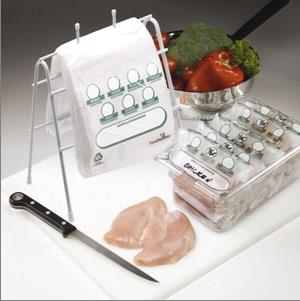Why Does Food Spoil?
 Food gradually deteriorates because of a natural process of aging, just like humans. However with all foods, there are a few things we can do that have a positive effect on the shelf life and safety of our foods at the restaurant. Some preservation is done at the food manufacturing plant, some naturally, but a better understanding of the processes may help you extend that shelf life. Preservation methods and storage conditions must be designed to reduce the rate of decomposition and protect the safety, appearance and taste of our food.
Food gradually deteriorates because of a natural process of aging, just like humans. However with all foods, there are a few things we can do that have a positive effect on the shelf life and safety of our foods at the restaurant. Some preservation is done at the food manufacturing plant, some naturally, but a better understanding of the processes may help you extend that shelf life. Preservation methods and storage conditions must be designed to reduce the rate of decomposition and protect the safety, appearance and taste of our food.
The causes of food spoilage – Plant and animal tissue starts to decay soon after raw food has been harvested or killed. The spoilage process is usually caused by microorganisms such as fungi (molds & yeasts), spoilage bacteria, and their enzymes. Not all these changes in food are undesirable. Some people like aged beef and cheeses or very ripe fruit. The production of wine and beer involves conversion of sugars to alcohol, while souring of milk is essential in the production of cheese.
However, it’s important to remember that some of the conditions that accelerate spoilage, such as inappropriate temperature and moisture control, also encourage the growth of pathogenic microorganisms that cause foodborne illness. Consequently, spoiled food is not just an issue of quality, it is also often a question of food safety.
Mold & Yeast: Corn, nuts, breads, meat, cheeses, fruits and vegetables are affected by mold. With most cheeses (i.e. cheddar, mozzarella, American, or Swiss), don’t try to salvage cheese that shows visible mold by cutting it away unless it’s a natural part of the cheese like bleu cheese, Brie, or Camembert. Mold forms a network of microscopic strands that extend into the foods which could cause allergic reactions or illness, so discard them. Most cheeses don’t improve with age. Deli meats are the same. Yeast can cause discoloration, slime, and odors on sweet, acidic refrigerated foods or jams/jellies.
 Bacteria: Some spoilage bacteria are also pathogenic (disease causing). For example, Clostridium perfringens (a common cause of spoilage in meat & poultry) and Bacillus cereus (spoils milk & cream) are also responsible for causing foodborne disease. Most foods are subject to bacterial growth.
Bacteria: Some spoilage bacteria are also pathogenic (disease causing). For example, Clostridium perfringens (a common cause of spoilage in meat & poultry) and Bacillus cereus (spoils milk & cream) are also responsible for causing foodborne disease. Most foods are subject to bacterial growth.
Enzymes: They are naturally present in the cells of microorganisms that break down animal and plant foods. Breakdown continues until the enzymes are inactivated by blanching or cooking.
Other causes of spoilage include: 1) bruising or piercing because of rough handling such as vegetables, fruits or vacuum packaged food; 2) oxidation (changes the taste or texture when exposed to oxygen) or freezer burn; 3) pest infestation because of poor receiving control, storage, rotation or cleaning; 4) adulteration by addition of leftover food to fresh food, inferior or undesirable food or ingredients.
Detecting spoilage includes the typical indicators such as appearance (discoloration or slime), texture, smell or taste (obviously not recommended if any of the others are present).
Bottom line – When in doubt, throw it out. Food spoilage does affect your bottom line in food waste dollars, so prevention includes good receiving inspection practices, following manufacturer’s instructions, utilizing innovative active packaging or food storage bags, unfailing temperature recording and control, being observant and certainly good sanitation and personal hygiene by food handlers.
***
About the Author: Lacie Thrall

READ MORE POSTS
Tis the Season!
Tis the Season!
Holiday Food Safety RX
There is always a lot to do during the holiday season with extra shopping, baking, social events, decorating, travel, and other tasks to complete. It is not uncommon to hear the rattle of OTC (over the counter) pain killers in other’s personal bags! In this blog, Jeannie and I offer our prescription for keeping food safety during the holidays.
Holiday Health
The holidays are here! (A reminder just in case you haven’t seen store decorations and TV ads!). This IS a special time of year with gatherings of friends and families to celebrate, reflect, and partake of food and drink. However, it is also the time of year where the Germ Grinch and excess stress can spoil all the fun. Don’t let that happen on your watch! Common sense practices, based on research and publications by CDC, can keep the Grinch at bay. FoodHandler® also focused on this topic in a recent webinar. In this blog, our first for December, some tips on how to stay healthy during the holidays (and the rest of the year) will be covered while the second blog will address some food handling and service strategies to keep you and your guests safe.
The Politics of Food Safety – Part Two
Hi everyone. Keeping with the theme of politics, our blog postings for the month of November are about food safety regulations. In the first blog, we provided background on agencies and their oversight for different foods. In this blog, we are covering elements of the Food Safety Modernization Act (FSMA) that was signed into law January of 2011.






